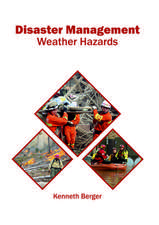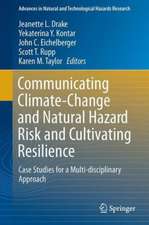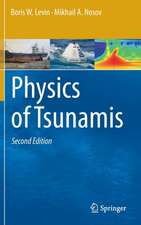Tsunami: The Underrated Hazard: Springer Praxis Books
Autor Edward Bryanten Limba Engleză Paperback – 30 noi 2010
| Toate formatele și edițiile | Preț | Express |
|---|---|---|
| Paperback (2) | 646.43 lei 6-8 săpt. | |
| Springer International Publishing – 3 sep 2016 | 646.43 lei 6-8 săpt. | |
| Springer Berlin, Heidelberg – 30 noi 2010 | 1026.83 lei 38-44 zile | |
| Hardback (1) | 589.56 lei 38-44 zile | |
| Springer International Publishing – 2 iul 2014 | 589.56 lei 38-44 zile |
Din seria Springer Praxis Books
-
 Preț: 294.46 lei
Preț: 294.46 lei -
 Preț: 223.45 lei
Preț: 223.45 lei -
 Preț: 193.12 lei
Preț: 193.12 lei -
 Preț: 167.85 lei
Preț: 167.85 lei -
 Preț: 288.98 lei
Preț: 288.98 lei -
 Preț: 323.74 lei
Preț: 323.74 lei -
 Preț: 401.38 lei
Preț: 401.38 lei -
 Preț: 264.12 lei
Preț: 264.12 lei - 8%
 Preț: 513.00 lei
Preț: 513.00 lei -
 Preț: 190.01 lei
Preț: 190.01 lei -
 Preț: 218.16 lei
Preț: 218.16 lei -
 Preț: 312.06 lei
Preț: 312.06 lei - 17%
 Preț: 414.04 lei
Preț: 414.04 lei -
 Preț: 216.41 lei
Preț: 216.41 lei -
 Preț: 262.27 lei
Preț: 262.27 lei -
 Preț: 264.35 lei
Preț: 264.35 lei -
 Preț: 167.63 lei
Preț: 167.63 lei -
 Preț: 284.81 lei
Preț: 284.81 lei -
 Preț: 259.08 lei
Preț: 259.08 lei -
 Preț: 305.47 lei
Preț: 305.47 lei -
 Preț: 244.14 lei
Preț: 244.14 lei -
 Preț: 227.85 lei
Preț: 227.85 lei -
 Preț: 285.25 lei
Preț: 285.25 lei -
 Preț: 295.56 lei
Preț: 295.56 lei -
 Preț: 357.17 lei
Preț: 357.17 lei -
 Preț: 275.79 lei
Preț: 275.79 lei -
 Preț: 257.08 lei
Preț: 257.08 lei -
 Preț: 349.71 lei
Preț: 349.71 lei -
 Preț: 272.45 lei
Preț: 272.45 lei -
 Preț: 270.27 lei
Preț: 270.27 lei - 8%
 Preț: 456.51 lei
Preț: 456.51 lei -
 Preț: 352.34 lei
Preț: 352.34 lei - 8%
 Preț: 394.80 lei
Preț: 394.80 lei -
 Preț: 320.65 lei
Preț: 320.65 lei -
 Preț: 325.29 lei
Preț: 325.29 lei -
 Preț: 253.11 lei
Preț: 253.11 lei -
 Preț: 192.86 lei
Preț: 192.86 lei -
 Preț: 313.40 lei
Preț: 313.40 lei -
 Preț: 150.51 lei
Preț: 150.51 lei -
 Preț: 233.34 lei
Preț: 233.34 lei -
 Preț: 286.78 lei
Preț: 286.78 lei -
 Preț: 212.01 lei
Preț: 212.01 lei -
 Preț: 366.83 lei
Preț: 366.83 lei -
 Preț: 299.99 lei
Preț: 299.99 lei -
 Preț: 232.27 lei
Preț: 232.27 lei -
 Preț: 284.58 lei
Preț: 284.58 lei -
 Preț: 212.45 lei
Preț: 212.45 lei -
 Preț: 159.81 lei
Preț: 159.81 lei -
 Preț: 349.48 lei
Preț: 349.48 lei - 20%
 Preț: 2061.61 lei
Preț: 2061.61 lei
Preț: 1026.83 lei
Preț vechi: 1351.09 lei
-24% Nou
Puncte Express: 1540
Preț estimativ în valută:
196.48€ • 205.14$ • 162.61£
196.48€ • 205.14$ • 162.61£
Carte tipărită la comandă
Livrare economică 01-07 aprilie
Preluare comenzi: 021 569.72.76
Specificații
ISBN-13: 9783642093616
ISBN-10: 3642093612
Pagini: 372
Ilustrații: XXXIV, 330 p. 58 illus., 6 illus. in color.
Dimensiuni: 170 x 242 x 20 mm
Greutate: 0.68 kg
Ediția:Softcover reprint of hardcover 2nd ed. 2008
Editura: Springer Berlin, Heidelberg
Colecția Springer
Seriile Springer Praxis Books, Geophysical Sciences
Locul publicării:Berlin, Heidelberg, Germany
ISBN-10: 3642093612
Pagini: 372
Ilustrații: XXXIV, 330 p. 58 illus., 6 illus. in color.
Dimensiuni: 170 x 242 x 20 mm
Greutate: 0.68 kg
Ediția:Softcover reprint of hardcover 2nd ed. 2008
Editura: Springer Berlin, Heidelberg
Colecția Springer
Seriile Springer Praxis Books, Geophysical Sciences
Locul publicării:Berlin, Heidelberg, Germany
Public țintă
ResearchCuprins
Tsunami as a known hazard.- Tsunami dynamics.- Tsunami-formed landscapes.- Signatures of tsunami in the coastal landscape.- Coastal landscape evolution.- Causes of tsunami.- Earthquake-generated tsunami.- Great landslides.- Volcanic eruptions.- Comets and asteroids.- Modern risk of tsunami.- Risk and avoidance.- Epilogue.
Recenzii
From the reviews of the second edition:
"A much needed, up-to-date introductory work on tsunamis with worldwide coverage. … Many high-quality maps, figures, charts, and exceptional photographs augment the text; an extensive list of cited references is especially valuable. This book will have noteworthy appeal to students and professionals alike in the fields of geomorphology, coastal engineering, environmental sciences, and economics. It will also be valuable to geographers, civic and emergency planners, and the general public living along coastlines the world over … . Summing Up: Recommended. All readers/libraries." (T. L. T. Grose, CHOICE, Vol. 46 (01), September, 2008)
“The main focus of the book was and remains the formation of landscape features by large tsunami. … The greatest value of this book may well be to raise awareness in the public and among policy makers … . the book very accessible to the general public and those who have limited scientific aptitude. … The book concludes with a discussion of modern tsunami risks and warning systems, followed by an epilogue which presents several plausible scenarios of future tsunami disasters.” (Michael Antolik, Pure and Applied Geophysics, Vol. 166, 2009)
"A much needed, up-to-date introductory work on tsunamis with worldwide coverage. … Many high-quality maps, figures, charts, and exceptional photographs augment the text; an extensive list of cited references is especially valuable. This book will have noteworthy appeal to students and professionals alike in the fields of geomorphology, coastal engineering, environmental sciences, and economics. It will also be valuable to geographers, civic and emergency planners, and the general public living along coastlines the world over … . Summing Up: Recommended. All readers/libraries." (T. L. T. Grose, CHOICE, Vol. 46 (01), September, 2008)
“The main focus of the book was and remains the formation of landscape features by large tsunami. … The greatest value of this book may well be to raise awareness in the public and among policy makers … . the book very accessible to the general public and those who have limited scientific aptitude. … The book concludes with a discussion of modern tsunami risks and warning systems, followed by an epilogue which presents several plausible scenarios of future tsunami disasters.” (Michael Antolik, Pure and Applied Geophysics, Vol. 166, 2009)
Notă biografică
Dr Edward Bryant is a renowned and respected tsunami researcher, writer and teacher in the areas of natural hazards and climatology. Tsunami: The Underrated Hazard was first published by Cambridge University Press in 2001. This is now out of print and CUP confirmed that all rights in the book have reverted to the author. The 2nd Edition incorporates the great Indian Ocean tsunami in 2004 and the author focuses on geomorphology and the processes and events linked to the main causes of tsunami, namely, earthquakes, volcanoes, landslides and, in addition, comet and meteorite impacts.
Textul de pe ultima copertă
Tsunami: The Underrated Hazard, 2nd Edition, comprehensively describes the nature and process of tsunami formation, outlines field evidence for detecting the presence of past events, and describes notable events linked to earthquakes, volcanoes, submarine landslides, and comet impacts. The author provides a clear approach to the study of tsunami, through dynamics, impact on coastlines, and overviews of the various major mechanisms of tsunami generation. Liberal case studies and examples highlight the significance of this underrated natural hazard for coastal societies. In particular, Dr Bryant studies in detail the great tsunami that struck the Indian Ocean on 26 December 2004, making it one of the largest natural disasters to occur in recorded history.
The book is divided into four parts. Part I considers tsunami as a known hazard, starting in Chapter 1 with legends and stories and questioning whether they are scientific fact or legend. Dr Bryant looks at the causes of tsunami, their distribution and fatalities in the Mediterranean and Caribbean Seas, the Pacific Ocean, New Zealand and Australia as well as in bays, fjords, inland seas and lakes. Chapter 2 studies the dynamics of tsunami, their characteristics, the wave theory and the run-up and inundation. In Part II tsunami-formed landscapes are examined, showing both the depositional and erosional signatures of tsunami in the coastal landscape, including chevrons and dune bedforms. The coastal landscape evolution is looked at in Chapter 4, comparing catastrophism against uniformitarianism and tsunami versus storms. Examples and types of coastal landscapes created by tsunami, particularly in Australia, Grand Cayman, the Bahamas and Chilean coast are also given. Part III looks at the main causes of tsunami: earthquakes, great landslides, volcanic eruptions and comets and meteorites. The modern risk of tsunami is covered in Part IV, detailing locations and avoidance, including warning systems. Dr Bryant ends this unique study of a fascinating subject with five stories of different tsunamis.
The book is divided into four parts. Part I considers tsunami as a known hazard, starting in Chapter 1 with legends and stories and questioning whether they are scientific fact or legend. Dr Bryant looks at the causes of tsunami, their distribution and fatalities in the Mediterranean and Caribbean Seas, the Pacific Ocean, New Zealand and Australia as well as in bays, fjords, inland seas and lakes. Chapter 2 studies the dynamics of tsunami, their characteristics, the wave theory and the run-up and inundation. In Part II tsunami-formed landscapes are examined, showing both the depositional and erosional signatures of tsunami in the coastal landscape, including chevrons and dune bedforms. The coastal landscape evolution is looked at in Chapter 4, comparing catastrophism against uniformitarianism and tsunami versus storms. Examples and types of coastal landscapes created by tsunami, particularly in Australia, Grand Cayman, the Bahamas and Chilean coast are also given. Part III looks at the main causes of tsunami: earthquakes, great landslides, volcanic eruptions and comets and meteorites. The modern risk of tsunami is covered in Part IV, detailing locations and avoidance, including warning systems. Dr Bryant ends this unique study of a fascinating subject with five stories of different tsunamis.
Caracteristici
Comprehensive and well illustrated textbook on all aspects of tsunami Can be used by a student or layperson to gain encyclopaedic knowledge about tsunami

























